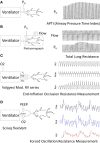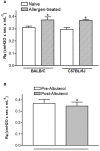Assessment of murine lung mechanics outcome measures: alignment with those made in asthmatics
- PMID: 23408785
- PMCID: PMC3569663
- DOI: 10.3389/fphys.2012.00491
Assessment of murine lung mechanics outcome measures: alignment with those made in asthmatics
Abstract
Although asthma is characterized as an inflammatory disease, recent reports highlight the importance of pulmonary physiology outcome measures to the clinical assessment of asthma control and risk of asthma exacerbation. Murine models of allergic inflammatory airway disease have been widely used to gain mechanistic insight into the pathogenesis of asthma; however, several aspects of murine models could benefit from improvement. This review focuses on aligning lung mechanics measures made in mice with those made in humans, with an eye toward improving the translational utility of these measures. A brief description of techniques available to measure murine lung mechanics is provided along with a methodological consideration of their utilization. How murine lung mechanics outcome measures relate to pulmonary physiology measures conducted in humans is discussed and we recommend that, like human studies, outcome measures be standardized for murine models of asthma.
Keywords: airway hyperresponsiveness; asthma; lung mechanics; murine; translational research.
Figures



Similar articles
-
Noninvasive Measurement of Pulmonary Function in Experimental Mouse Models of Airway Disease.Lung. 2021 Jun;199(3):255-261. doi: 10.1007/s00408-021-00443-9. Epub 2021 May 19. Lung. 2021. PMID: 34009429 Free PMC article. Review.
-
Peripheral lung mechanics in asthma: exploring the outer limits.Pulm Pharmacol Ther. 2011 Apr;24(2):199-202. doi: 10.1016/j.pupt.2010.12.001. Epub 2010 Dec 10. Pulm Pharmacol Ther. 2011. PMID: 21146626 Review.
-
Impacts of allergic airway inflammation on lung pathology in a mouse model of influenza A virus infection.PLoS One. 2017 Feb 28;12(2):e0173008. doi: 10.1371/journal.pone.0173008. eCollection 2017. PLoS One. 2017. PMID: 28245238 Free PMC article.
-
Effect of a retinoid X receptor partial agonist on airway inflammation and hyperresponsiveness in a murine model of asthma.Respir Res. 2017 Jan 23;18(1):23. doi: 10.1186/s12931-017-0507-z. Respir Res. 2017. PMID: 28114934 Free PMC article.
-
TSG-6 protein is crucial for the development of pulmonary hyaluronan deposition, eosinophilia, and airway hyperresponsiveness in a murine model of asthma.J Biol Chem. 2013 Jan 4;288(1):412-22. doi: 10.1074/jbc.M112.389874. Epub 2012 Nov 1. J Biol Chem. 2013. PMID: 23118230 Free PMC article.
Cited by
-
Genetic Deletion of β-Arrestin-2 and the Mitigation of Established Airway Hyperresponsiveness in a Murine Asthma Model.Am J Respir Cell Mol Biol. 2015 Sep;53(3):346-54. doi: 10.1165/rcmb.2014-0231OC. Am J Respir Cell Mol Biol. 2015. PMID: 25569510 Free PMC article.
-
Role for β-arrestin in mediating paradoxical β2AR and PAR2 signaling in asthma.Curr Opin Pharmacol. 2014 Jun;16:142-7. doi: 10.1016/j.coph.2014.03.007. Epub 2014 Jun 5. Curr Opin Pharmacol. 2014. PMID: 24907413 Free PMC article. Review.
-
Ascaris lumbricoides Cystatin Prevents Development of Allergic Airway Inflammation in a Mouse Model.Front Immunol. 2019 Sep 27;10:2280. doi: 10.3389/fimmu.2019.02280. eCollection 2019. Front Immunol. 2019. PMID: 31611876 Free PMC article.
-
Respiratory mechanics evaluation of mice submitted to intravenous methacholine: Bolus vs. continuous infusion.Exp Biol Med (Maywood). 2020 Apr;245(8):680-689. doi: 10.1177/1535370220912393. Epub 2020 Mar 17. Exp Biol Med (Maywood). 2020. PMID: 32183551 Free PMC article.
-
Plethysmography Phenotype QTL in Mice Before and After Allergen Sensitization and Challenge.G3 (Bethesda). 2016 Sep 8;6(9):2857-65. doi: 10.1534/g3.116.032912. G3 (Bethesda). 2016. PMID: 27449512 Free PMC article.
References
-
- Allakhverdi Z., Allam M., Renzi P. M. (2002). Inhibition of antigen-induced eosinophilia and airway hyperresponsiveness by antisense oligonucleotides directed against the common β chain of IL-3, IL-5, GM-CSF receptors in a rat model of allergic asthma. Am. J. Respir. Crit. Care Med. 165, 1015–1021 - PubMed
-
- Amdur M. O., Mead J. (1958). Mechanics of respiration in unanesthetized guinea pigs. Am. J. Physiol. 192, 364–368 - PubMed
-
- Arron J. R., Jia G.-Q., Erickson R. W., Choy D. F., Mosesova S., Solberg O. D., et al. (2011). Periostin is a systemic biomarker of eosinophilic airway inflammation in asthma. Am. J. Respir. Crit. Care Med. 183, A4455
Grants and funding
LinkOut - more resources
Full Text Sources
Other Literature Sources

